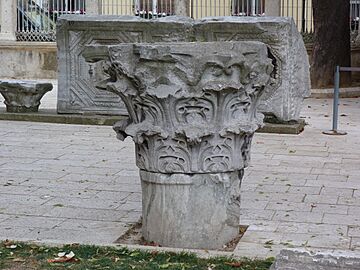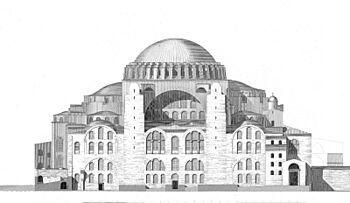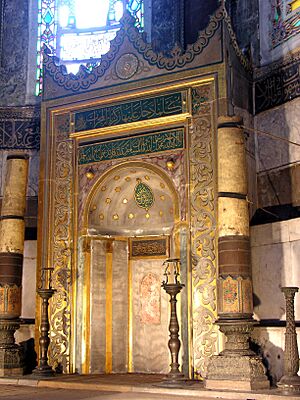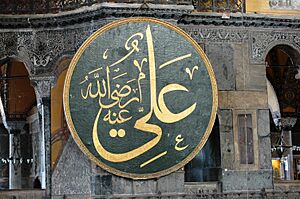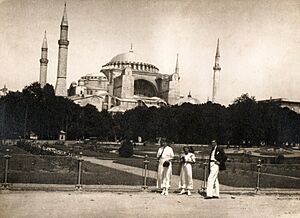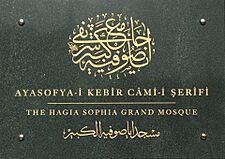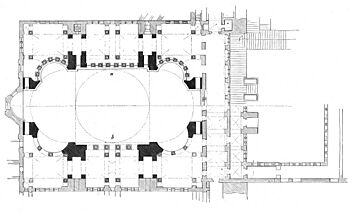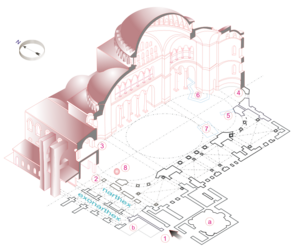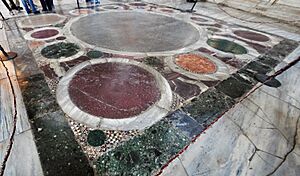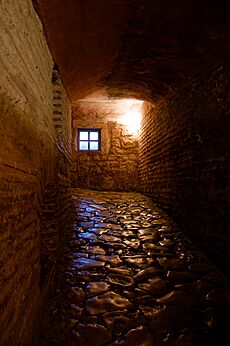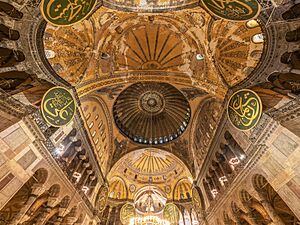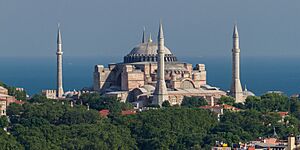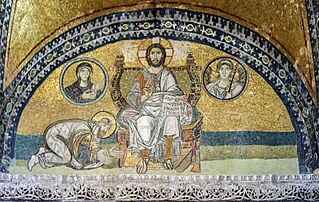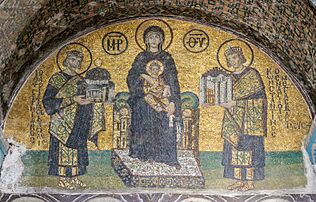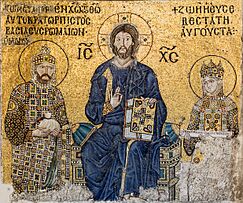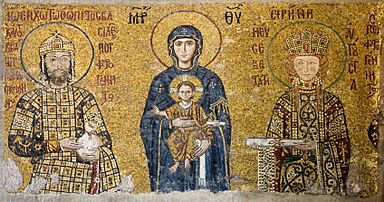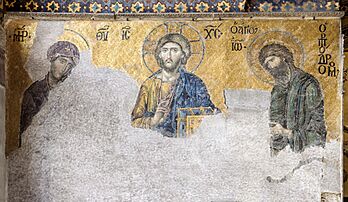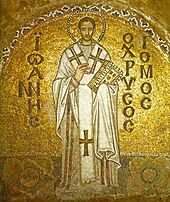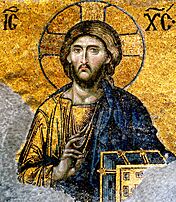Hagia Sophia facts for kids
|
|
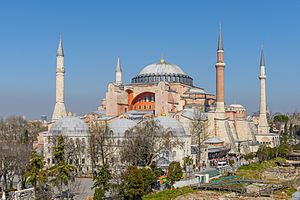
Hagia Sophia Church was built in AD 537, with minarets added in the 15th–16th centuries when it became a mosque.
|
|
| Coordinates | 41°00′30″N 28°58′48″E / 41.00833°N 28.98000°E |
|---|---|
| Location | Fatih, Istanbul, Turkey |
| Designer | |
| Type |
|
| Material | Ashlar, Roman brick |
| Length | 82 m (269 ft) |
| Width | 73 m (240 ft) |
| Height | 55 m (180 ft) |
| Beginning date | c. 346 |
| Completion date | 360 |
| Restored date |
|
| Dedicated to | The Holy Wisdom, a reference to the second person of the Trinity, or Jesus Christ |
| UNESCO World Heritage Site | |
| Part of | Historic Areas of Istanbul |
| Criteria | Cultural: i, ii, iii, iv |
| Inscription | 1985 (9th Session) |
Hagia Sophia is a very famous building in Istanbul, Turkey. It has been a church, a mosque, and a museum at different times in history. Today, it is a mosque again and a major cultural and historical site. Its name, Hagia Sophia, means "Holy Wisdom" in Greek.
This amazing building was first completed in 537 AD by the Eastern Roman Empire. For a long time, it was the largest indoor space in the world. It was also one of the first buildings to use a special type of dome called a pendentive dome. Many people think it's a perfect example of Byzantine architecture and that it changed how buildings were designed forever.
From 360 AD until 1453, Hagia Sophia was a Christian cathedral in Constantinople (which is now Istanbul). There was a period from 1204 to 1261 when Crusaders took over and it became a Catholic church. After the fall of Constantinople in 1453, it became a mosque, and its tall towers called minarets were added. In 1935, it was turned into a museum. Then, in 2020, it was changed back into a mosque. Since 2024, the upper floor has also served as a museum again.
The current building was built by the Byzantine emperor Justinian I between 532 and 537. It was designed by two Greek mathematicians and engineers, Isidore of Miletus and Anthemius of Tralles. It was officially called the "Church of God's Holy Wisdom." This was the third church built on the same spot, as the earlier one was destroyed in riots. For almost a thousand years, it was the largest cathedral in the world, until the Seville Cathedral was finished in 1520.
Hagia Sophia became a model for many other churches and mosques. Its unique style inspired many buildings, including famous Ottoman mosques built much later.
For nearly a thousand years, it was a very important center for the Eastern Orthodox Church. It was dedicated to "Holy Wisdom," which refers to Jesus Christ. The church is seen as a special place in the Christian world and a symbol of Byzantine culture. In 1054, an event happened here that helped start the big split between the Eastern Orthodox and Catholic Churches. In 1204, during the Fourth Crusade, it became a Catholic church, but it was returned to the Eastern Orthodox Church in 1261.
After the Ottoman Empire took Constantinople in 1453, Sultan Mehmed the Conqueror turned it into a mosque. It was the main mosque in Istanbul until the Sultan Ahmed Mosque was built in 1616. Hagia Sophia stayed a mosque until 1931, when it was closed for four years. In 1935, it reopened as a museum under the new, secular Republic of Turkey. It became Turkey's most visited tourist spot by 2019.
In 2020, a court decision changed its status back to a mosque. This decision caused a lot of discussion and different opinions around the world.
Contents
- History of Hagia Sophia
- Architecture of Hagia Sophia
- Important Art and Decorations
- Other Interesting Features
- Buildings Inspired by Hagia Sophia
- Images for kids
- See also
History of Hagia Sophia
Hagia Sophia has a long and interesting history, with different buildings standing on the same spot over many centuries.
The First Church (360–404)
The first church on this site was called the "Great Church" because it was so big compared to other churches in the city. It was dedicated on February 15, 360, during the time of Emperor Constantius II. It had a wooden roof and faced west. It was likely shaped like a Roman building with a large open area in front called an atrium.
This first church was mostly burned down during riots on June 20, 404.
The Second Church (415–532)
A second church was ordered by Emperor Theodosius II and opened on October 10, 415. This church was also very large. It had a main entrance that faced west, possibly with golden doors. The outside was decorated with detailed carvings, and the floor inside had colorful mosaics.
This second Hagia Sophia was completely burned down during the Nika riots on January 13–14, 532.
The Current Building (532–Present)
Just a few weeks after the second church was destroyed, Emperor Justinian I started building a third, even grander church on February 23, 532. He chose two famous architects, Anthemius of Tralles and Isidore of Miletus, to design it.
The building was finished very quickly, in just under six years. It was officially opened on December 27, 537. Hagia Sophia became the main church for the Patriarch of Constantinople and was used for important ceremonies, like coronations of emperors.
The outside of the church was originally covered with shiny marble. The inside had colorful marbles, green, white, and purple, along with gold mosaics. This made Hagia Sophia look very bright and grand.
When Emperor Justinian saw the finished building, he reportedly said, "Solomon, I have surpassed thee!" This showed how proud he was of this amazing creation.
Earthquakes and Repairs
Hagia Sophia has faced many challenges, especially from earthquakes. In 553 and 557, earthquakes caused cracks in the main dome. In 558, part of the dome collapsed. Emperor Justinian ordered immediate repairs. A new dome was built by Isidorus the Younger, using lighter materials. This new dome was also built higher, making the building 55.6 m (182 ft) tall inside. This reconstruction was finished in 562.
Over the centuries, more earthquakes caused damage. In 869, a half-dome collapsed. Emperor Basil I ordered repairs. In 989, the western dome arch fell. Emperor Basil II asked an Armenian architect named Trdat to fix it. He rebuilt the dome with 15 ribs, and the church reopened in 994. New decorations, including paintings of angels and a depiction of Christ, were added.
During the Crusades
In 1204, during the Fourth Crusade, the church was badly damaged and looted by Crusaders. Many valuable items and gold mosaics were taken. The church became a Catholic cathedral during the Latin occupation (1204–1261). Enrico Dandolo, the leader of the Venetian Crusaders, was buried inside the church.
When the Byzantine Empire regained Constantinople in 1261, the church was in poor condition. Repairs were made, and in 1317, new supports were added. More parts of the building collapsed after an earthquake in 1344. Repairs continued until 1354.
The Fall of Constantinople (1453)
On December 12, 1452, a short-lived union between the Catholic and Orthodox Churches was announced in Hagia Sophia. However, many Byzantines did not like this.
When the Ottoman Empire attacked Constantinople in 1453, many people sought refuge in Hagia Sophia. They hoped for safety, but after the city's walls were broken, the Ottoman soldiers entered the church. The building was looted, and many people inside were taken as slaves.
Hagia Sophia as a Mosque (1453–1935)
After Constantinople fell on May 29, 1453, Sultan Mehmed II entered the city. He ordered Hagia Sophia to be converted into a mosque right away. An Islamic scholar climbed onto the church's pulpit and recited the shahada, which is the Muslim declaration of faith. This marked the change of the church into a mosque.
Sultan Mehmed II ordered the building to be renovated. He attended the first Friday prayer there on June 1, 1453. Hagia Sophia became the first imperial mosque of Istanbul.
Over time, minarets were added to the building. Sultan Bayezid II built one at the northeast corner. Later, the famous Ottoman architect Mimar Sinan added two large minarets at the western end during the reign of Sultan Selim II. These minarets are about 60 m (200 ft) tall.
In the 16th century, Sultan Suleiman the Magnificent brought two huge candlesticks from Hungary and placed them next to the mihrab (a niche showing the direction of Mecca). During his time, many of the Christian mosaics were covered with plaster.
In the 18th century, Sultan Mahmud I ordered a big restoration. He also added a school, a soup kitchen for the poor, and a library, turning Hagia Sophia into a large social complex.
The 1847–1849 Renovation
In the 19th century, Sultan Abdulmejid I ordered a major restoration of Hagia Sophia. This work was done by two Swiss-Italian architect brothers, Gaspare and Giuseppe Fossati, between 1847 and 1849. They strengthened the dome and walls and improved the building's decorations.
They also uncovered and cleaned some of the old mosaics in the upper gallery. Eight huge circular medallions with beautiful Arabic calligraphy were hung inside. These had the names of Allah, Muhammad, and important early Islamic leaders. The Fossati brothers also repaired the minarets, making them all the same height. The mosque reopened after this restoration on July 13, 1849.
Hagia Sophia as a Museum (1935–2020)
In 1935, Mustafa Kemal Atatürk, the first President of Turkey, changed Hagia Sophia into a museum. The carpets and plaster covering the marble floor were removed, revealing the original 6th-century floor decorations. Some of the Christian mosaics that had been covered were also uncovered.
However, the building still needed a lot of care. The roof cracked, causing water to leak and damage the old frescoes and mosaics. The World Monuments Fund helped with restorations from 1997 to 2006, focusing on the dome and roof.
By 2014, Hagia Sophia was the second most visited museum in Turkey, with almost 3.3 million visitors each year. Even as a museum, a small prayer room was allowed in 1991, and the call to prayer was regularly broadcast from its minarets starting in 2013.
Hagia Sophia as a Mosque Again (2020–Present)
Starting in the early 2010s, there were calls to change Hagia Sophia back into a mosque. On July 10, 2020, a court decision canceled the 1935 order that made it a museum. Turkish President Recep Tayyip Erdoğan then signed a decree to officially change its status back to a mosque.
This decision was met with mixed reactions. Many Muslim leaders welcomed it, while some international organizations like UNESCO and Christian leaders expressed sadness and concern. Turkey stated that it was a matter of its own country's decision and that the building would remain open to everyone, Muslims and non-Muslims, outside of prayer times.
On July 22, 2020, a turquoise carpet was laid inside. The first Friday prayers were held on July 24, 2020. The Christian mosaics of the Virgin and Child were covered with white drapes during prayer times. Since January 15, 2024, foreign visitors have to pay an entrance fee to visit the mosque.
Architecture of Hagia Sophia
Hagia Sophia is one of the most important examples of Byzantine architecture. Its inside is decorated with beautiful mosaics, marble pillars, and coverings. It was the largest cathedral ever built at the time and remained so for 1,000 years.
The building was constructed using bricks and mortar. The mortar joints are very wide, about 1.5 times the width of the bricks. This mix of sand and small ceramic pieces is similar to ancient Roman concrete. A lot of iron was also used to strengthen the structure.
Hagia Sophia's design was a major achievement for its time and greatly influenced later church and mosque architecture in many parts of the world.
The Grand Interior
The inside of Hagia Sophia is very large and complex. The main area, called the nave, is covered by a huge central dome. This dome is about 55.6 m (182 ft 5 in) high from the floor. It rests on an archway with 40 windows, which help bring light into the building. The dome is slightly oval-shaped, with a diameter between 31.24 and 30.86 m (102 ft 6 in and 101 ft 3 in).
On the western and eastern sides, there are large half-domes that extend the space, making the interior feel even bigger. The entire main space is about 76.2 m (250 ft) long.
The Floor
The stone floor of Hagia Sophia is from the 6th century. After the first dome collapsed, a new floor was laid over the old one. This floor became an important part of the church's ceremonies, with special areas marked by different colored stones.
Most of the floor is made of white marble from Marmara Island. Other parts, like the green "verd antique" marble, came from Greece. The green bands across the floor were often compared to rivers or the sea. Many writers described the floor as looking like a "sea in a storm" or a "petrified sea." The floor was covered by a carpet on July 22, 2020.
Narthex and Doors
The Imperial Gate was the main entrance, used only by the emperor. It is the largest door in Hagia Sophia, about 7 metres (23 ft) tall, and dates back to the 6th century. Some old stories say it was made from wood from Noah's Ark.
The Nice Door is the oldest part of the building, dating back to the 2nd century BC. It has carvings of geometric shapes and plants. It was added to the church in 838.
Upper Gallery
The upper gallery is shaped like a horseshoe and surrounds the main nave on three sides. This area was traditionally used by the Empress and her court. Some of the best-preserved mosaics are found here.
In the northern part of the first-floor gallery, there are runic writings believed to have been left by Vikings who served as guards.
The Dome
The dome of Hagia Sophia is famous for its innovative design. It rests on four triangular supports called pendentives. This was one of the first times such a large dome was built this way. The dome is about 32.6 metres (107 ft) wide and only 0.61 metres (2 ft 0 in) thick.
The weight of the dome has always been a challenge. The first dome collapsed in 558. The new dome, built in 563, was raised higher to reduce pressure on the walls. It also had 40 ribs, like an umbrella, to help distribute the weight.
Hagia Sophia is known for the beautiful light inside, which makes the dome seem to float. This effect is created by 40 windows around the base of the dome.
Buttresses
Over the centuries, many large supports called buttresses have been added to the outside of the building to help hold up the heavy dome and walls. Some of these were built during the Byzantine era, and others were added by the Ottoman architect Mimar Sinan. A total of 24 buttresses were added to the building.
Minarets
The tall, slender minarets were added by the Ottomans after Hagia Sophia became a mosque. The first wooden minaret was built by Sultan Mehmed II. Later, Sultan Bayezid II and Mimar Sinan added the stone minarets we see today. The two larger minarets on the west side are about 60 m (200 ft) tall.
Important Art and Decorations
When it was first built, Hagia Sophia's interior had abstract designs on marble walls and floors, and mosaics on the curved ceilings. Later, more detailed mosaics were added, but some were destroyed during a period when religious images were not allowed (called Byzantine Iconoclasm). The mosaics we see today are from after that period.
After it became a mosque, many mosaics were covered with plaster because Islam generally does not allow pictures of people or animals in places of worship. However, some travelers in the 17th century still reported seeing Christian images.
19th and 20th Century Restorations
During the 1847–1849 restoration by the Fossati brothers, they documented many mosaics they found, but then covered them again for protection. Their drawings are now important records of what the mosaics looked like.
In the 1930s, a team led by Thomas Whittemore uncovered many mosaics when Hagia Sophia became a museum. They chose to leave some simple cross images covered but revealed all the major mosaics.
Restoring Hagia Sophia is a challenge because it has been both a church and a mosque. Restorers try to keep a balance between both Christian and Islamic art. For example, there's a discussion about whether the Islamic calligraphy on the dome should be removed to show a possible mosaic of Christ underneath.
Famous Mosaics
- Imperial Gate Mosaic: This mosaic is above the Imperial Gate, which only emperors used. It shows an emperor bowing before Christ Pantocrator (Christ as Ruler of All), who is holding a book. It was likely made in the late 9th or early 10th century.
- Southwestern Entrance Mosaic: Found above the southwestern entrance, this mosaic is from the time of Emperor Basil II. It shows the Virgin Mary on a throne with the Christ Child on her lap. On her left, Emperor Constantine the Great offers a model of the city, and on her right, Emperor Justinian I offers a model of Hagia Sophia.
- Apse Mosaics: In the half-dome above the apse (the eastern end), there is a mosaic of the Virgin Mary holding the Christ Child, seated on a jeweled throne. This mosaic is considered one of the most important Byzantine artworks. It was covered for a long time during the Ottoman era and rediscovered in the 19th and 20th centuries.
- Emperor Alexander Mosaic: This mosaic is on the second floor in a dark corner. It shows Emperor Alexander in his royal clothes, holding a scroll and a globe with a cross. It was thought to be destroyed but was rediscovered in 1958.
- Empress Zoe Mosaic: On the eastern wall of the southern gallery, this mosaic from the 11th century shows Christ Pantocrator in the middle. He is flanked by Emperor Constantine IX Monomachus and Empress Zoe, both in ceremonial clothes. They are offering gifts to the church. The faces of the emperor and empress were changed over time, possibly to show different rulers.
- Comnenus Mosaic: Also in the southern gallery, this mosaic from 1122 shows the Virgin Mary with the Christ Child. On her right is Emperor John II Komnenos, and on her left is his wife, Empress Irene of Hungary. Their son, Alexius Comnenus, is on a nearby pillar. This mosaic shows more realistic faces compared to older ones.
- Deësis Mosaic: This mosaic, probably from 1261, is in the upper galleries. It is considered one of the most beautiful mosaics in Hagia Sophia. It shows the Virgin Mary and John the Baptist asking Christ Pantocrator to have mercy on humanity on Judgment Day. The bottom part is damaged, but the faces are very expressive and lifelike.
- Northern Tympanum Mosaics: These mosaics in the northern archway show important saints, including the Patriarchs of Constantinople, John Chrysostom and Ignatios of Constantinople. They are dressed in white robes and holding Bibles.
- Dome Mosaic: The dome was decorated with four large, six-winged angels. These are either seraphim or cherubim, who protect the Throne of God. The ones on the eastern side are original mosaics, while the ones on the western side are painted copies. During the Ottoman period, their faces were covered with metallic stars, but these were removed in 2009 to reveal the faces.
Other Interesting Features
- Loggia of the Empress: This is a special area in the middle of the upper gallery where the empress and her court would watch ceremonies. A green stone disc on the floor marks where the empress's throne stood.
- Lustration Urns: Two huge marble urns, carved from single blocks of marble, were brought from Pergamon by Sultan Murad III. They were used for ritual washing.
- Marble Door: This door in the southern upper gallery was used by church officials during meetings. People say one side represents heaven and the other represents hell. It has carvings of fruits and fish.
- Wishing Column: In the northwest part of the building, there's a column with a hole covered by bronze plates. It's called the "wishing column" or "sweating column." Legend says it's been moist since a saint appeared there, and touching the moisture is believed to cure illnesses.
- Viking Inscription: A 9th-century Viking inscription that reads "Halvdan was here" was found in the southern section of Hagia Sophia. It was likely left by a Viking soldier serving in the Byzantine army.
Buildings Inspired by Hagia Sophia
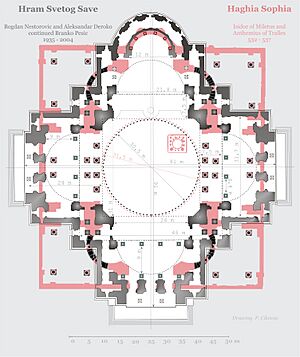
Many buildings around the world have been inspired by Hagia Sophia's unique design, especially its large central dome supported by half-domes.
Some Byzantine churches, like the Hagia Sophia, Thessaloniki and the Hagia Irene, were influenced by its style. Many later churches, especially those built in a Neo-Byzantine style, also copied its design. Examples include the Kronstadt Naval Cathedral and the Holy Trinity Cathedral, Sibiu.
Several mosques built by the Ottoman rulers, such as the Süleymaniye Mosque and the Bayezid II Mosque, also used Hagia Sophia's plan as a model.
Images for kids
See also
 In Spanish: Santa Sofía para niños
In Spanish: Santa Sofía para niños
- Runic inscriptions in Hagia Sophia
- List of tallest domes
- List of oldest church buildings


